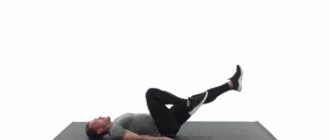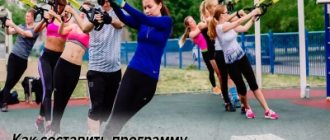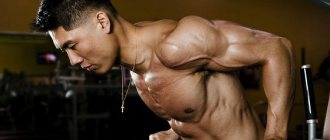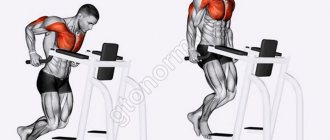Inflated abs are the goal of all fitness enthusiasts. Exercises for the abdominal muscles are present in the program of every athlete; the majority still prefer crunches and sit-ups in various variations. Let's see how to reach a new level of pumping the press on the horizontal bar and uneven bars.
Do you want to give elasticity and definition to your abs? You don't have to buy expensive exercise equipment or do boring, monotonous movements. Effective abdominal training can be done using parallel bars and a horizontal bar.
Such exercises will be useful not only for those who are starting to exercise, but also for those who spend a lot of time visiting gyms.
Abdominal training on the horizontal bar
Before you begin exercises on the horizontal bar, you should stretch and warm up your body. Jogging or any other cardio activity is suitable for this. Bend sideways and back and forth to stretch your back and abdominal muscles.
When the warmth rises in the lumbar region, you can begin performing basic exercises.
Hanging Leg Raise
Grab the horizontal bar with an overhand grip and hang. As you exhale, slowly raise your legs to the bar, while trying not to bend your knees. Don't try to do a lot of reps, this is just a warm up rep.
This exercise not only strengthens the abdominal muscles, but also helps get rid of excess fat in the abdomen, lower back and buttocks.
Hanging leg raises
Knee Raise
After completing the previous exercise, immediately proceed to perform knee raises. Slowly raise your bent legs towards your chest. In addition to working the rectus abdominis, this exercise also works the oblique muscles.
Hanging Knee Raise
To make them work more efficiently, you can raise your knees not directly to your chest, but offset to the left and right. Perform this abdominal exercise on the horizontal bar to failure.
Static exercise “Corner”
After taking a short break, move on to a static exercise called a “corner”. While hanging, raise your legs at an angle of 90 degrees and stay in this position for the maximum amount of time.
This exercise not only loads the abdominal muscles, but also perfectly strengthens the lower back. When performing this exercise, it is important to ensure that your torso does not sway from side to side.
Exercise "Scissors"
From the standard hanging position, you must first tense your abdominal muscles, thereby engaging the necessary muscle group, and alternately lift your straightened legs, thereby simulating the work of scissors. For the first classes, you need to perform 15-20 repetitions with each leg.
Crunches on the horizontal bar
An unusual version of the abdominal exercise on the horizontal bar is bending at the waist, twisting until the body is fully raised, while supporting the body weight not on the arms, but on the legs. In essence, the exercise remains the same as with a traditional leg raise, the only difference is that the person hangs upside down.
However, in fact, this option uses other muscle groups. In this position, you can also twist left and right to work the obliques. Although this exercise is quite easy to perform, it has great potential.
Lateral crunches on the horizontal bar
Next, hooking your feet to the horizontal bar, you need to perform twists with a slope to the side one by one. In order not to fall off, it is better to use special boots that are equipped with hooks for hooking onto the crossbar.
Press on the horizontal bar with weights
Once you have mastered the exercises described above and they are too light for you, you can start training with weights. To do this, use special weights on the legs or vests. This workout will be useful for working out your abdominal muscles, so be sure to use weights in your workouts.
To add variety to your workouts, which will positively affect your results, try incorporating abdominal exercises on the uneven bars into your program. Below is a basic set of exercises for developing abdominal muscles on this apparatus.
Exercises on the crossbar and parallel bars: what and how to do correctly
If you are overweight, you must first adjust your diet and limit the amount of fats and carbohydrates in your diet. Fat burners and cardio exercises (running, cycling, jumping rope) will help you lose weight faster.
In order for abdominal exercises on uneven bars to bring only benefits, you need to follow these rules:
- Before training, strengthen your arm muscles with push-ups.
- Then try to stand on straight arms and hold for 10 seconds. Gradually increase the time to 1 minute.
- Try to pull yourself up, first bend your arms a little, and then completely.
- Learn to rise as you inhale, and descend as you exhale.
- Make sure your grip is correct, with your thumb down.
- Perform the exercises smoothly, without sudden movements, as there is a risk of injury.
- Don't swing, move using your abdominal muscles.
This is interesting! If you have weak hands and they constantly slip, then use straps. They are put on the hands in a loop, and the free edge is wrapped around the crossbar. This will take the stress off your hands. However, it is recommended to use them at first; later you still need to train your grip.
The horizontal bar and parallel bars will help pump up all the abdominal muscles. In addition, during exercise the spine is stretched, and this is an excellent prevention of osteochondrosis and other diseases from this group.
Hanging Knee Raise
This exercise is for beginners, girls, athletes with some spinal defects (scoliosis, hyperlordosis of the lower back or thoracic spine, the initial stage of intervertebral disc protrusion).
The technique for performing this element is quite simple. You need to hang on the bar, tense your abdominal muscles, bend your knees and try to press them to your chest.
This exercise is suitable for beginner athletes whose muscles have not yet strengthened. It is enough to repeat 8-15 times twice or thrice.
Alternate hanging knee raises
This element helps pump up the lateral abdominal muscles. The athlete grabs the base and lifts first his right and then his left leg, bent at the knee. The load is small but effective. Repeat 10-15 times three times for each leg.
“Bicycle” and “scissors” on the horizontal bar
“Bicycle” is a variant of alternate leg lifts with the knees bent. Hang on the horizontal bar, raise your knees one by one, but without stopping. When one leg is at the top point, the second immediately begins to move. The frequency of repetition is from 10 to 15 times three times.
The technique for performing the previous exercise and “Scissors” is similar, the difference is that you need to move with straight legs, not bent ones. The athlete grabs the bar and makes movements similar to walking.
These exercises are enough for a beginner to strengthen their muscles. Over time, you can increase the number of repetitions. And when you feel that it’s easy for you, then move on to more complex elements.
Hanging straight leg raise
This and all the following exercises are suitable for experienced athletes who have strong abdominal muscles and good coordination.
Technique:
- Hang on the parallel bars.
- Smoothly raise your straight legs so that they are parallel to the floor.
- Hold for a few seconds.
Perform 10 to 15 times three times.
A little later, try to touch your toes to the base.
"Frog"
They say that the famous Bruce Lee liked this exercise. But to pump up your abdominal muscles, you need to do it correctly. To do this, grab the base and try to pull your knees towards your chin. If it’s hard for you, then at first you can stretch to your stomach, then to your chest.
You need to fixate at the top point until you feel a burning sensation in the muscles.
Repeat “Frog” 20 to 25 times three times.
“Windshield wipers”
This element is so called because during its execution the legs move like windshield wipers.
Technique:
- Pull yourself up a little with your arms (to a 90° angle at your elbows), while at the same time smoothly lift your legs in front of you.
- Lean your torso back slightly.
- Move your legs straight to the right, while turning your buttocks to the left. Then repeat on the other side. At the highest point, when your thighs are almost parallel to the floor, lock in.
Do 10 to 12 repetitions twice or thrice.
Corner
This exercise differs from a regular leg raise in that once the legs are raised, they need to be held in that position. The longer the athlete holds on, the more he will stress the abdominal muscles.
This is interesting! The corner can be done differently: move your legs when they are parallel to the floor to the sides. This way you will pump up your oblique muscles.
Twisting
At first, this element resembles a “Frog,” but after the athlete raises his knees to his chest, he turns them first to the right and then to the left. At the maximum point you need to fixate for a few seconds. The element is repeated 10-15 times on each side three times.
The twist will strengthen the side abdominal muscles.
roman chair
Athletes know that parallel bars are 2 pipes that are located side by side, so they can be used like a Roman chair. Bars allow you to strengthen your back and abdominal muscles.
Technique:
- Sit on one pipe so that it is under the buttocks, secure your ankle to the other.
- Place your hands on the back of your head or chest.
- Tilt your body down so that it is parallel to the floor. The back should be rounded or flat; you should not arch it at the lower back.
The exercise is performed 15 times twice or three times.
If your back hurts after training, first strengthen it with simpler exercises, such as hyperextension.
Be sure to check out:
Making a slender waist and tightening the abs: exercises and tips A set of exercises for the abs and legs: a set of workouts for the muscles, buttocks, thighs Details on how to properly pump the abs to remove belly fat How to pump up the oblique abdominal muscles: basic exercises
Features of parallel bars training
It is generally accepted that parallel bars are a simple apparatus for performing exercises mainly on the arms and upper body. All this is true until you try to practice.
In order to keep the body suspended on the bars, you already need to spend a lot of effort. And after you start doing the exercises, all thoughts about the ease of execution immediately disappear. As a basic training, we will analyze the following video.
To start training on the parallel bars for an unprepared person, you must first take a course to strengthen your arm muscles. Each exercise begins with lifting your own weight with straight arms.
With prolonged loads in this position, the muscles cannot stand it and the arms begin to bend and slip. To avoid getting seriously injured, you need to be properly prepared.
Contraindications should be taken into account
Due to the characteristics of each organism, performing certain exercises is not possible. A clear example of this is being overweight. As a rule, overweight people are unable to perform a number of exercises.
In this case, it is better to develop the arm muscles, starting with the simplest push-ups from the surface and only then move on to practice on the uneven bars.
Such exercises are also contraindicated for sore joints. Whether it is an injury or chronic pain, you should not start exercising until the cause is eliminated. After the preparation has been completed, you can begin practical exercises to pump up your abs.
Preparing the body for parallel bars
It would seem that there is nothing complicated about exercises on the parallel bars for the press. Many could observe how easily and simply the sculpted guys in the gym performed them without any effort. But we have to admit that observing this is much easier than doing it yourself.
To perform the exercises, you need to thoroughly warm up your muscles.
First, you need to test your strength and hold yourself for a certain period of time in the starting position: straight arm stand. This is where the first difficulties begin, because not everyone is able to hold their own body. It's normal practice for your arms to curl, your palms to hurt, or the feeling that you're about to slip off the apparatus. It is worth remembering that this stance is the starting position for most exercises.
It will be much easier for a person weighing between 60-80 kilograms than for someone whose weight significantly exceeds the established limits. But in any case, before the actual exercises, you need to strengthen the arm muscles and prepare the joints for the load. To do this, resort to regular push-ups from the floor.
Remember that it is better for an unprepared person not to use the projectile.
Exercises on parallel bars for the abs
The main difficulty is that during exercise the load falls on the arms. Injuries are common under heavy loads, so it is important to do a preparatory warm-up before each session to avoid damaging a muscle or joint.
Preparation is an important part of working out the abdominal muscles. First, you need to know the limits of your capabilities. It is necessary to step onto the uneven bars with straight arms. Your legs should be pressed to your chest at this time. Remain in this state for at least a minute. This will give you the opportunity to fully complete each exercise.
Another training option is dips. From the position of outstretched arms, you need to do a full push-up. If you can’t do it the first time, you need to practice and improve the skill.
Walk on the uneven bars
A great way for beginners. It allows you to master the basics and at the same time gives the necessary load on the abdominal muscles.
In an extended arms stand, you need to raise one knee to a level above the bars. Smoothly lowering it, we begin to raise the second knee. As a result, the exercise resembles walking with your knees raised high.
Corner on uneven bars
From the starting position, you need to raise your straight legs above the level of the parallel bars. For the first lessons, it is better to lean forward slightly during the exercise. Thus, the center of gravity of the body shifts, preventing it from swaying.
An important feature is the level to which you raise your legs. The higher you can raise them, the more muscles are involved in the exercise. Ideally, you should pull your legs towards your chest. In this way, both the lower and upper parts of the muscles are used.
Over time, this exercise becomes easier to perform. To increase the load, you can use leg weights, thereby increasing your mass.
Roman chair on parallel bars
To perform this exercise, you need to sit on one bar of the parallel bars. The legs are tucked under the second crossbar and a backward bend is made. It is important to ensure that the bar is just below your buttocks to avoid folding when twisting.
The exercise must be performed without jerking, with your hands clasped behind your head. 12-15 twists are performed in one approach.
Recommendations for pumping up the press on uneven bars
- you need to ensure that the body does not sway during the exercise;
- Be sure to use special gloves of your size for classes to avoid damaging your hands and getting calluses. This will also contribute to good adhesion to the projectile;
- when it’s cold outside, you need to use warm gloves with open fingers;
- Find low bars to avoid serious injury if you accidentally fall.
Compliance with all rules and recommendations, as well as regular training will inevitably lead to the desired result. Work on yourself, and everything will definitely work out!
Exercises on the horizontal bar and uneven bars
To engage the lower abs, straight leg raises are suitable. In order for the load to fall more on the upper part, you need to perform twists from a hanging position upside down. Don’t forget about the oblique muscles, which are perfectly pumped when turning.
The main advantage of using these exercises is that the body does not have a fulcrum as it does not come into contact with surfaces. In this position, the entire load falls on the muscles, thereby increasing efficiency.
Advantages and disadvantages of standing leg raises
Let's start with the advantages:
- Uniform load on muscles. The parallel bars, or rather the vertical position of the body, allows you to work the rectus abdominis muscle, involving in the work the lower part of the rectus muscle, which is least involved in straight crunches on the floor.
- Burns more calories. Compared to exercises on the floor, lifting on parallel bars is a more energy-consuming exercise, as it requires additional fixation of the body in the simulator, due to which the muscles of the shoulder girdle are involved in the static load.
- The presence of a support allows you to eliminate body swaying, for example, as when hanging on a bar, which makes the exercise technique clearer and more concentrated.
Disadvantages of the exercise:
- Quite a difficult exercise that requires good position stabilization . When the elbows and lower back are supported, the load on the shoulder girdle is not reduced. If the shoulder and chest muscles are untrained, there is a high probability that the neck will sag under the shoulders, which will additionally overload the trapezius muscle and the sternocleidomastoid muscle of the neck, which will also make breathing difficult.
- Weak abdominal muscles will also not cope with the load , despite the fact that the exercise is intended to strengthen them. In addition to dynamic lifts, the abdominal muscles are also responsible for stabilizing the body in the machine, controlling the fit of the lower back to the back of the machine and are in constant tension, which cannot be interrupted during the approach. Let's return to this point in technology. Therefore, you should start doing leg raises on the uneven bars only after mastering the option lying on the floor.
What you need to know to practice on the horizontal bar and uneven bars
It will be easier to master such training not alone, but in a company. Quite often you can see sports guys gathering around the horizontal bar and taking turns doing exercises.
The fact is that during collective training there is a competitive spirit, which helps to bear the load and receive an assessment from the outside about the correctness of the exercise.
Simple rules
1. Even breathing during exercise plays an important role, so it is so important to follow this rule. If this condition is met, you receive:
- Reducing the load on the heart
- Correct muscle contraction
- Keeping the rhythm
During exercise, these factors influence both the health of the body as a whole and the achievement of the expected result. For each athlete, breathing sets a certain rhythm, which is important to maintain in order not only to achieve results, but also to cause harm.
2. Every movement should be smooth. This applies not only to the training itself, but also when approaching the apparatus and even when jumping off the horizontal bar. Getting injured means, at a minimum, being suspended from school for some time.
It is important to know that the number of repetitions is not the key factor when working the abdominal muscles. During slow but correct repetition, the load is much higher, which means the result will be more effective.
If during exercise your body sways quite strongly, you will have to resort to the help of your friends to hold you. The whole point is contained in the correct execution, which eliminates jerky movement.
3. Do not allow your hands to slip. The fact that sweating occurs when a person is active is not news to anyone. This leads to hands slipping along the horizontal bar and, as a result, can lead to a fall. To avoid this, you can use gloves or magnesium to prevent your hands from slipping.
With insufficient practice, the hands often tire much faster than the abdominal muscles. For this case, you can use straps or belts that can reduce the load on your hands and increase the time you perform the exercises.
For twisting from a hanging position, there is also a device that helps you stay on the horizontal bar without falling head down.
Warm-up
As mentioned earlier, warming up is no less important than the exercises themselves. To warm up your back muscles, you need to bend over. If you feel warmth in the lumbar region, you can begin to warm up your arms. Swings, bending, warming up your wrists, all this will help protect yourself from joint injury.
To stretch your arm muscles, you can use the same horizontal bar, hanging on it for as long as possible. Finally, light squats are performed so that the whole body is ready to perform the exercises. We offer the following simple link.
Technique, general rules of execution
When performing any abdominal exercise, it is important to follow the correct technique, without which you cannot achieve the desired result.
Let's look at the basic principles of performing leg raises on uneven bars:
- After you climb onto the bars, you need to immediately press your pelvis and back tightly against the support, or, if there is no support, achieve an even vertical position of your body.
- Then smoothly raise your legs in a straight position or using a chair. The position of your legs plays the last role here, since your task is not to lift them, but to twist your pelvis and work with it.
- When you reach the maximum point of the twist, exhale deeply. You need to feel a lot of tension in your abdominal muscles. Returning to the starting position, inhale the air again.
- Perform 20 repetitions in 3-4 sets, gradually increasing the load.
- You should not make fast or crumpled movements. It is better to perform them more slowly, but more elaborately.
By following the correct technique, you will protect yourself from injury and make progress.
Watch the video that talks about the features of the exercise and shows how to do it correctly:
Improved abdominal exercise
Side bends with dumbbells
- 3 sets of 10 reps
- Body part: Press Equipment: Dumbbells
Pulling your legs to your chest on a horizontal bench
- 3 sets of 15 reps
- Body part: Press Equipment: Body weight
Hanging Knee Raises
- 3 sets of 30 seconds
- Body Part: Press Equipment: No
Quadriceps stretch while kneeling
- 3 sets of 30 seconds
- Body part: Quadriceps Equipment: Body weight
Squats without weights
- 5 minutes max reps
- Body part: Quadriceps Equipment: Body weight
Add to Calendar * Add to My Workouts * Print Workout
* — The service is in beta testing
Adapt it to your conditions as necessary.
What muscles work when lifting legs on parallel bars?
Main muscles:
We recommend reading: Exercises for beautiful hands for women at home
- Rectus abdominis muscle.
- External oblique abdominal muscles.
- The rectus femoris and iliopsoas muscles are involved in bringing the legs toward the body.
Muscles involved in position stabilization:
- Sternocleidomastoid muscle.
- Deltoid.
- Pectoralis major muscle.
- Biceps brachii muscle.
- Triceps brachii muscle.
Secrets of ripped abs
Abdominal exercises on the horizontal bar may not be enough to achieve perfect, sculpted abs.
- Regular cardio exercise is required to get rid of the fat layer on the abdomen that hides the abdominal muscles. Without this, you simply will not be able to see muscle relief.
- You should reconsider your diet. If you currently eat everything indiscriminately, then begin a gradual transition to healthy foods.
- Your table should contain minimally processed foods: avoid fast foods, processed foods, and high-calorie desserts. It is better to choose whole grain bread, cereals, lean meat, vegetables, fruits, and dairy products.
- No more than 3-3.5 hours should pass between meals. To eat healthy and regularly, take time every evening to create your menu for the next day.
Abdominal training on the horizontal bar and parallel bars
For more effective results, you can combine exercises on the horizontal bar, parallel bars and on the ground. As one option, you can use a program of 4 exercises:
- Walk on bars, 3 x max
- Roman chair on parallel bars, 3 x 20
- Hanging leg raises, 3 x 20
- Scissors on the crossbar, 3 x 20
- Corner on the horizontal bar, 3 x max
All exercises are performed based on physical capabilities. At the initial stage, you can take 3 sets of 10-15 repetitions.











